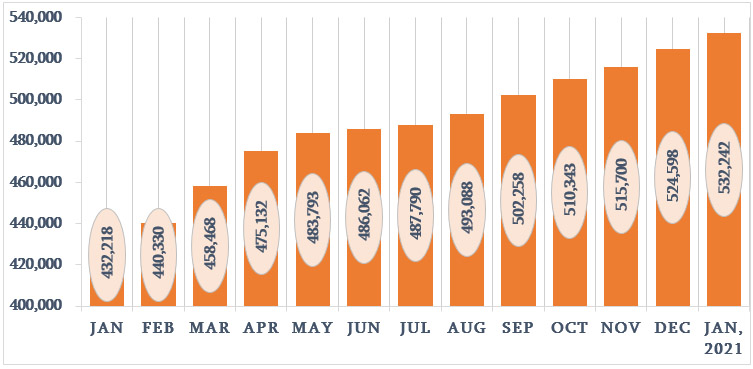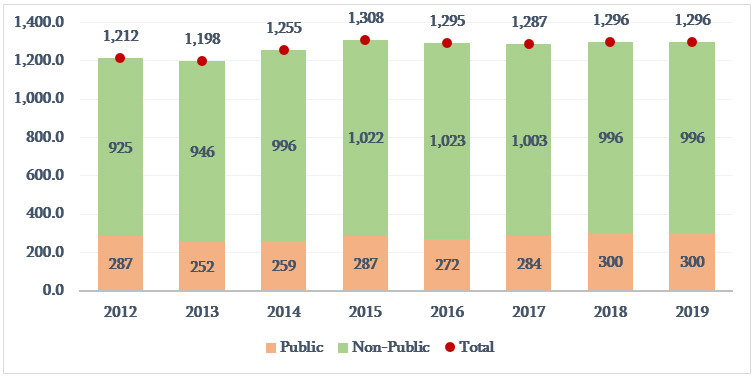Ana Natsvlishvili: “The number of socially vulnerable people increased by 100,000 last year… 27,000 jobs were lost before the pandemic.”
Verdict: FactCheck concludes that Ana Natsvlishvili’s statement is MOSTLY TRUE.
Resume: As of January 2021, the number of cash social assistance recipients is 532,242. As compared to January 2020, the number of cash social assistance (subsistence assistance) recipients rose by 100,024. This growth is stipulated by the pandemic-induced crisis and the expanded government assistance programme as part of the anti-crisis plan.
As compared to the previous year, the number of hired employees increased by 6,000 in 2019 whilst the number of self-employees increased by 5,700. In sum, the total number of employees shrank by 0.3 thousand.
The figure in Ana Natsvlishvili’s statement is in line with the long-running (2017-2019) trend of decreased employment in the private sector. However, she did not specify in her statement whether or not she was referring to the private sector. In addition, Ms Natsvlishvili also did not specify a concrete period. Since 2016, the number of employees in the non-public (private) sector has been decreasing annually. In 2017-2019, the number of private sector employees dropped by 26,400 whilst at the same time the number of public sector employees increased by 27,800.
Analysis
Lelo for Georgia political union member, Ana Natsvlishvili, stated on air on the Tavisupali Khedva television show: “The number of socially vulnerable people increased by 100,000 last year and many more are lined up… 27,000 jobs were lost before the pandemic.”
The government’s cash social assistance (subsistence assistance) programme aims to provide cash and other relevant assistance to families below the poverty line. A family’s socio-economic standing is measured by a respective methodology which determines the family’s rating points. The amount of cash assistance and other preferences are determined on the basis of a family’s rating points.
As of January 2021, there are 1,020,375 citizens (333,292 families) registered in the database of socially vulnerable families. The number of people registered in the database of socially vulnerable families increased by 97,802 (27,703 families).
As of January 2021, the number cash social assistance (subsistence assistance) recipients amounts to 532,242 people (148,653 families). As compared to January 2020, the number of cash social assistance (subsistence assistance) recipients rose by 100,024 (27,973 families).
Of note is that in order to mitigate the socio-economic damage caused by the pandemic and the associated restrictions, the targeted social assistance programme was expanded as part of the government’s anti-crisis plan. Therefore, the number of assistance recipients also increased.
Graph 1: Number of Subsistence Assistance Recipients: January 2020 – January 2021

Source: Social Service Agency, Statistical data of subsistence assistance recipients
Ana Natsvlishvili also mentioned the jobs that were lost before the pandemic. According to the National Statistics Office of Georgia, the number of employees in 2019 decreased by 0.3 thousand as compared to the previous year. Of importance is that the number of hired employees decreased by 6,000 whilst the number of self-employees increased by 5,700. The year 2019 was one of the worst years in terms of employment statistics when cuts in employment were caused by the decrease in the number of hired employees.
Under the Georgian Dream’s rule, employment in Georgia peaked in 2015. In 2016-2017, the number of employees decreased and the total employment increased again in 2018 at the expense of the growth of public service employees, soon to be followed by more cuts in employment in 2019 (see Graph 2).
Since 2016, the number of employees in the non-public sector has been decreasing annually. In 2017-2019, the number of private sector employees dropped by 26,400 whilst at the same time the number of public sector employees increased by 27,800.
The figure in Ana Natsvlishvili’s statement is in line with the decreased employment in the private sector 2017-2019.
Graph 2: Number of Employees in Terms of Employment Sectors in 2012-2020 (Thousand Persons)

Source: National Statistics Office of Georgia
The National Statistics Office of Georgia also publishes the number of jobs in the business sector based on the declared data of enterprises. The number of jobs in the business sector increases annually although the number of jobs does not equate the same number of employed individuals. A working-age person can possibly have two or more jobs. Those politicians who speak about jobs usually do not refer to the number of jobs in the business sector but to the general employment statistics instead.








